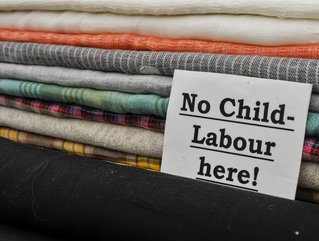Modern slavery: AI technology and supply chain transparency

Hi, please introduce yourself and your role.
“Hello, I’m Katrina Duck, an Enterprise Account Executive at Inspectorio. I work closely with some of the largest brands and retailers worldwide, specialising in our sustainability and compliance platform, Inspectorio Rise. With over a decade of experience in supply chain, my focus has been on sourcing and promoting transparency, including sustainability, visibility, and traceability. I have worked in New York and London and am currently based in Hong Kong.”
Hi Katrina, could you start by telling us a little about Inspectorio?
“Inspectorio aims to build an interconnected, sustainable and transparent supply chain with cloud-based SaaS solutions. Inspectorio helps brands, retailers, manufacturers and suppliers manage risk through digitised quality and sustainability programmes and is used by over 8,000 customers globally, including some of the world's largest brands and retailers. Headquartered in Minneapolis, MN, Inspectorio has over 300 employees globally.”
Over the past few years, there has been a strong examination of historical slavery. However, modern slavery continues to be a significant problem for our society. Can you tell us why?
“The term "modern slavery" encompasses any situation in which an individual is exploited by another and deprived of their freedom for someone else's financial gain. This broad definition includes human trafficking, individuals born into servitude, child and forced labour, as well as domestic servitude, child marriages, and debt bondage.
“It’s hard to put a finger on the exact number, but some statistics say that almost 50mn people are trapped in slavery. It would also be misleading to say that this issue is only prevalent in poor or underdeveloped countries (although they are more vulnerable) — modern slavery is hidden in various forms across the globe.
“Modern slavery thrives in challenging social backgrounds, poverty, and poorly regulated markets. There is also a strict correlation between slavery and migratory flows caused by climate change or geopolitical and economic crises. It's terrible yet intuitive: the farther people are from their social safety nets, the more vulnerable and desperate they become, making them more likely to trust anyone who offers a way out.”
Do you have any slavery statistics you can share with us?
“The report Global Estimates of Modern Slavery 2022, written by the International Labour Organization (ILO), Walk Free and the International Organization for Migration (IOM), presented some scary data. Out of the 50mn people trapped in slavery, half are children. Labour slavery affects 27.6mn people, including 17.3mn in the private economy and 3.9mn subjected to state-imposed forced labour.
“They often form the first stage of huge and complex supply chains, including garments, technological products or automotive goods.
“What do all products have in common? They are part of long value chains, and go through multiple stages of production, making it challenging to track all the materials and their origin. Traditionally, the business world has struggled to address this issue through corporate social responsibility initiatives. A mix of intentionally low visibility from raw material producers and incredibly low prices (leading to high profits) has made it complicated for businesses to act effectively.
“What I can say is that there has been a great shift in perception regarding modern slavery. We know we can’t pretend anymore that what happens in the rest of the world is not our problem. We have the internet, videos, and photos — we can’t just ignore the problem.
“Today, consumers demand more transparency from brands and want to know exactly where their products come from and how they are made. Similarly, regulators require accountability from big companies and organisations.
“It's crucial to understand that this is a global issue that cannot be tackled by a single human, company, or organisation alone. Collaboration across all actors and industries on a global level is essential to effectively combat modern slavery.”

What is the Transparency in Supply Chains Act?
“The California Transparency in Supply Chain Act was the first regulation in this direction. It was 2010, and finally, a precedent was set to eradicate modern slavery and human trafficking. Its objective is to oblige companies to be more transparent and open to their consumers about the potential use of modern slavery to create their products.
“Since then, similar regulations have been passed in the UK, Germany, Norway and the US. Among the others is the Uyghur Forced Labor Prevention Act of 2021, a strict policy on China's Xinjiang Uyghur Autonomous Region with the goal of ensuring that American entities are not funding forced labour among ethnic minorities in the region.
“More than ten years after introducing the first regulation against modern slavery, however, there is still a long way to go. For example, although the 2015 UK Modern Slavery Act obliged big businesses to report on all the steps, they take to tackle modern slavery in their supply chains, 40% of businesses have been found to not comply with the Modern Slavery Act at all. In fact, to be compliant, companies are only required to make the necessary disclosures, even if they do little to safeguard their supply chains.
“Another regulation worth mentioning is the EU Directive on Corporate Sustainability Due Diligence, which will impact multinational companies based or with significant turnover generated in Europe.”
How can companies navigate compliance and regulations?
“Every regulation is different, and it takes time and expertise to understand and apply them to each company's context. At the same time, once organisations structure their processes to act in the “right way,” I believe they will be able to respond to any given regulation effectively.
“I find the OECD Guidelines for Multinational Enterprises and responsible supply chain management to be an interesting and pragmatic resource in this sense. The guidelines present an approach to the due diligence process that can be applied to virtually any organisation.
- Train and empower your employees and decision-makers while embedding responsible sourcing principles in your internal policies. They need to know how the process works.
- Engage external stakeholders, including suppliers, NGOs, and opinion leaders, to help you identify potential areas of risk and suggest how to tackle them.
- Recognise and reward transparency from your suppliers by asking them questions and regular updates. Be aware that transparency may come with a cost for them as well. You can also use audits and certifications to support and incentivise their efforts.
- Track the implementation of your results.
- Communicate internally and externally about your progress.”
How can new AI-driven technology help them to do so?
“Transparency is the worst enemy of exploiters and one of the best ways to build trust between brands, suppliers and final customers.
“The more information you collect on your supply chains, the more reliable and available it becomes to all, and the smaller the space for poor working conditions and human rights violations.
“Technology is a great ally in this regard — it allows us to collect, store, access, and analyse an unprecedented amount of data, including documents, pictures, and certificates. All digital transactions, including workers’ salaries, can be tracked and those same workers have accessible digital tools to report violations. By building a strong compliance and due diligence programme, companies can access in real-time how many and what kind of violations were found in any given country or factory around the globe, unlike before.
“Artificial Intelligence can take this to the next level. Technology can be trained to recognise inconsistencies, identify trends and recurring risks, and help decision-makers make responsible and data-driven decisions. Most business decisions, in fact, are still taken based on perceptions and intuitions that can often be misleading.
“However, I am not saying technology will save us and solve all our problems. As we have mentioned, phenomena like slavery and human trafficking are directly or indirectly linked to global, uncontrollable challenges, or deeply embedded in the culture and economic dynamics. Data does not make sense if the way in which it is collected and interpreted is not correct, and this is why human commitment from regulators, customers, and the business world is essential.”
What do the next 12 months hold for you?
“Inspectorio has this mission ingrained in its DNA. Our vision is to lead the transformation of the global production chain into an interconnected, sustainable, and empowered production network.
“Transparency is the guiding principle that will steer us for the next 12 months. Our vision is to become an all-in-one sustainability and compliance platform, including strategic partnerships with industry leaders, to support our clients to:
- Achieve sustainability and compliance objectives with new services such as GHG (Green House Gases) emission calculation, labour conditions and regulatory compliance.
- Empower suppliers with dedicated advisory, unique resources, and capacity building.
- Increase visibility, visualise and map all suppliers beyond tier 1, and keep track of production activities and inspections.
- Identify and mitigate risks, know the health of supply chains and take immediate action on critical situations.
- Enable product order traceability by tracing all transactions from finished goods to the farm/forest/field level.
“We anticipate that by providing all these services, our clients will be able to effectively share progress towards sustainability and transparency with the world while driving material impact across global and complex supply chains. With most of these services available or in progress, we are confident that we are on the right track by offering products that simplify and streamline data collection, storage and reporting processes.”






